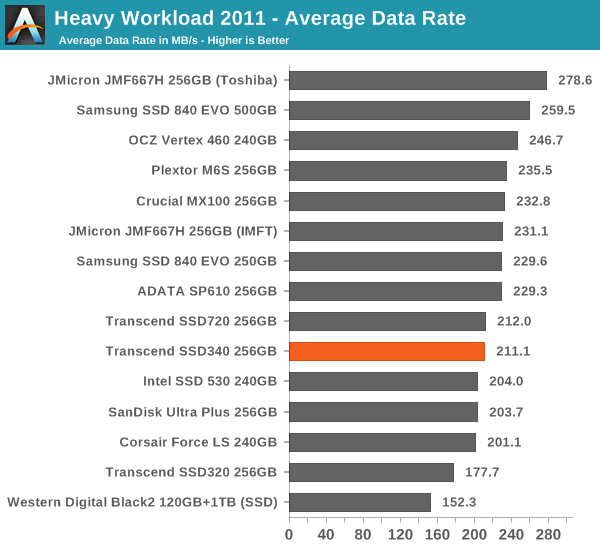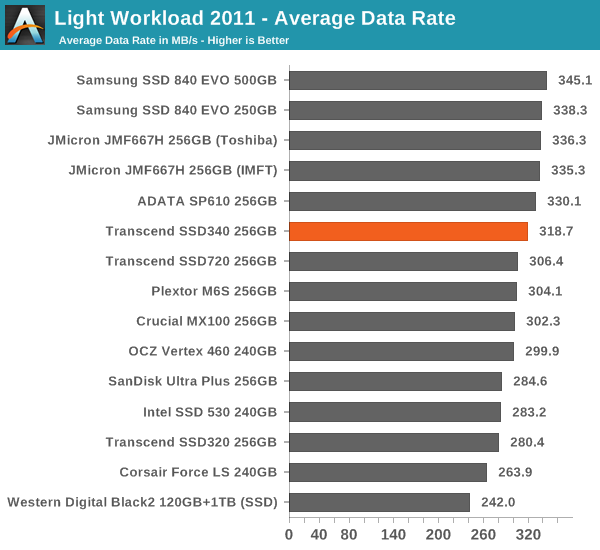Transcend SSD340 (256GB) Review
by Kristian Vättö on August 4, 2014 5:00 AM ESTAnandTech Storage Bench 2011
Back in 2011 (which seems like so long ago now!), we introduced our AnandTech Storage Bench, a suite of benchmarks that took traces of real OS/application usage and played them back in a repeatable manner. The MOASB, officially called AnandTech Storage Bench 2011 – Heavy Workload, mainly focuses on peak IO performance and basic garbage collection routines. There is a lot of downloading and application installing that happens during the course of this test. Our thinking was that it's during application installs, file copies, downloading and multitasking with all of this that you can really notice performance differences between drives. The full description of the Heavy test can be found here, while the Light workload details are here.

Fortunately the performance is much better in our 2011 Storage Benches. It looks like the JMF667H does fairly well in terms of peak performance but as soon as you fill the drive and start playing with consistency, the performance will take a massive hit.











57 Comments
View All Comments
TonyCL6 - Wednesday, August 6, 2014 - link
SSD370 should be pretty much the same as AData SP610 because of the controller and NAND configuration.Per Hansson - Monday, August 4, 2014 - link
The more things change the more they stay the same seems a fitting quote for this Transcend's SSD endeavors!homerdog - Monday, August 4, 2014 - link
Unless these drives fall way down the price ladder, there simply no reason for them to exist.MadMan007 - Monday, August 4, 2014 - link
Is there any budget SSD that makes sense in a world where the MX100 exists?Samus - Monday, August 4, 2014 - link
This drive (and this company) is completely irrelevant. I don't get why anybody would buy a drive outside of the Crucial/Micron/Intel/Samsung/Toshiba/Sandisk circle.Kingston, ADATA, Transcend, OWC, Mushkin, Corsair, and so on, make no compelling products and can't compete with Sandisk/Crucial on price because they don't make their own memory, controllers, or both.
hojnikb - Tuesday, August 5, 2014 - link
Pretty much. Unless you're owning a fab it's pretty hard to compete price wise.TonyCL6 - Wednesday, August 6, 2014 - link
Frankly for consumer market, only Samsung and maybe Toshiba has its own SSD controllers. The rest are now mainly using Marvell solutions. Kingston, ADATA, Transcend, OWC, Mushkin, Corsair and so on help Micron(Intel) and Toshiba(Sandisk) a lot to support/ consume their NAND Flash capacity. If they all gone, I personally don't think that would do any good to end-users. You can easily tell from how Samsung sells TLC and VNAND products. The cost of NAND is way much cheaper but that never reflects on the selling price.l_d_allan - Tuesday, August 5, 2014 - link
As Butch Cassidy said, "Don't sugar-coat it" :-)StrangerGuy - Tuesday, August 5, 2014 - link
Anandtech should just probably come blunt and say "If you can't beat the MX100 in price/performance/reliability don't even THINK about selling consumer SSDs thank you very much"Readers that visit this site ain't fooled no matter how much ads or exposure that comes down our throats.
hojnikb - Tuesday, August 5, 2014 - link
But its true. Why buy a turd, if you can speds a few extra bucks and get a proper drive.